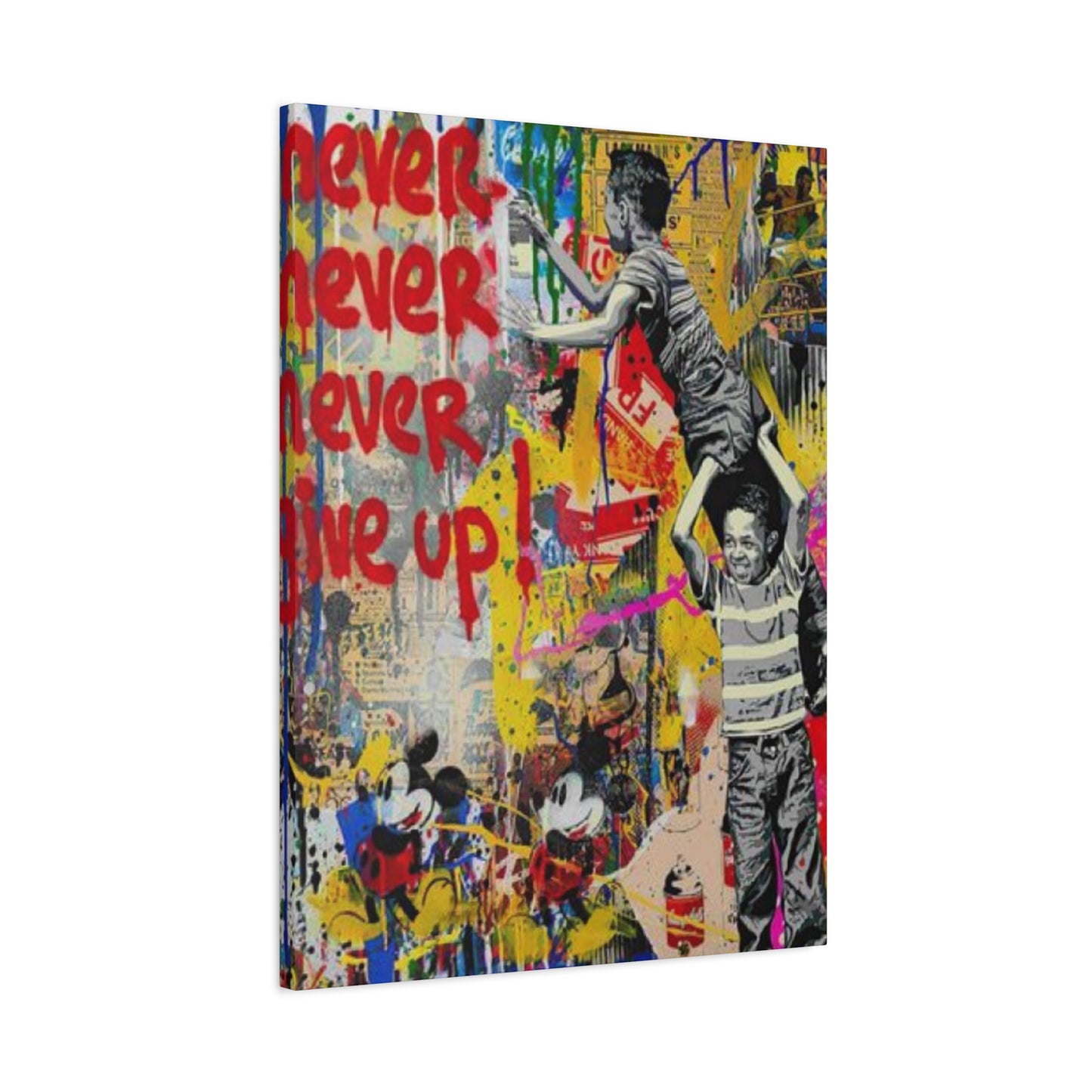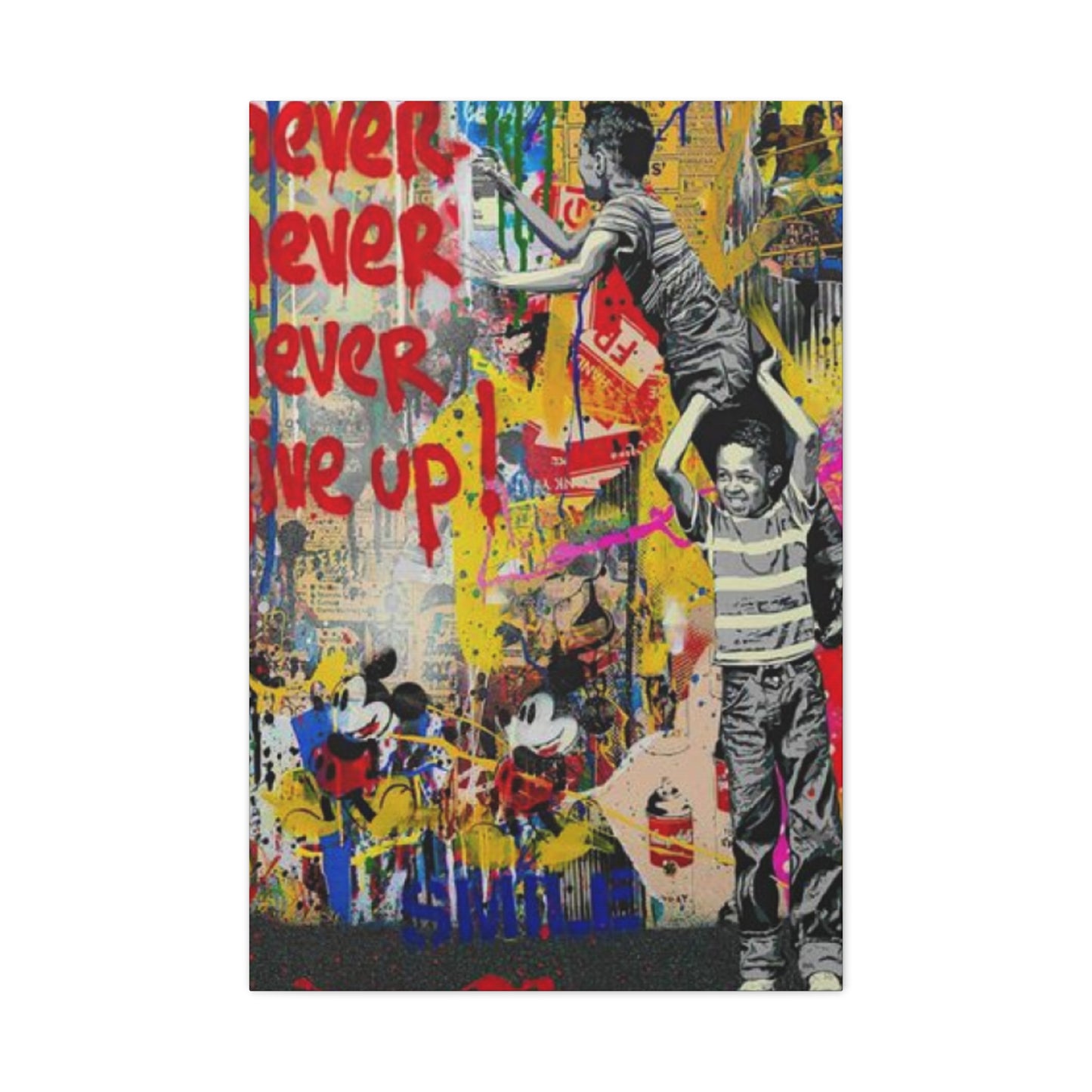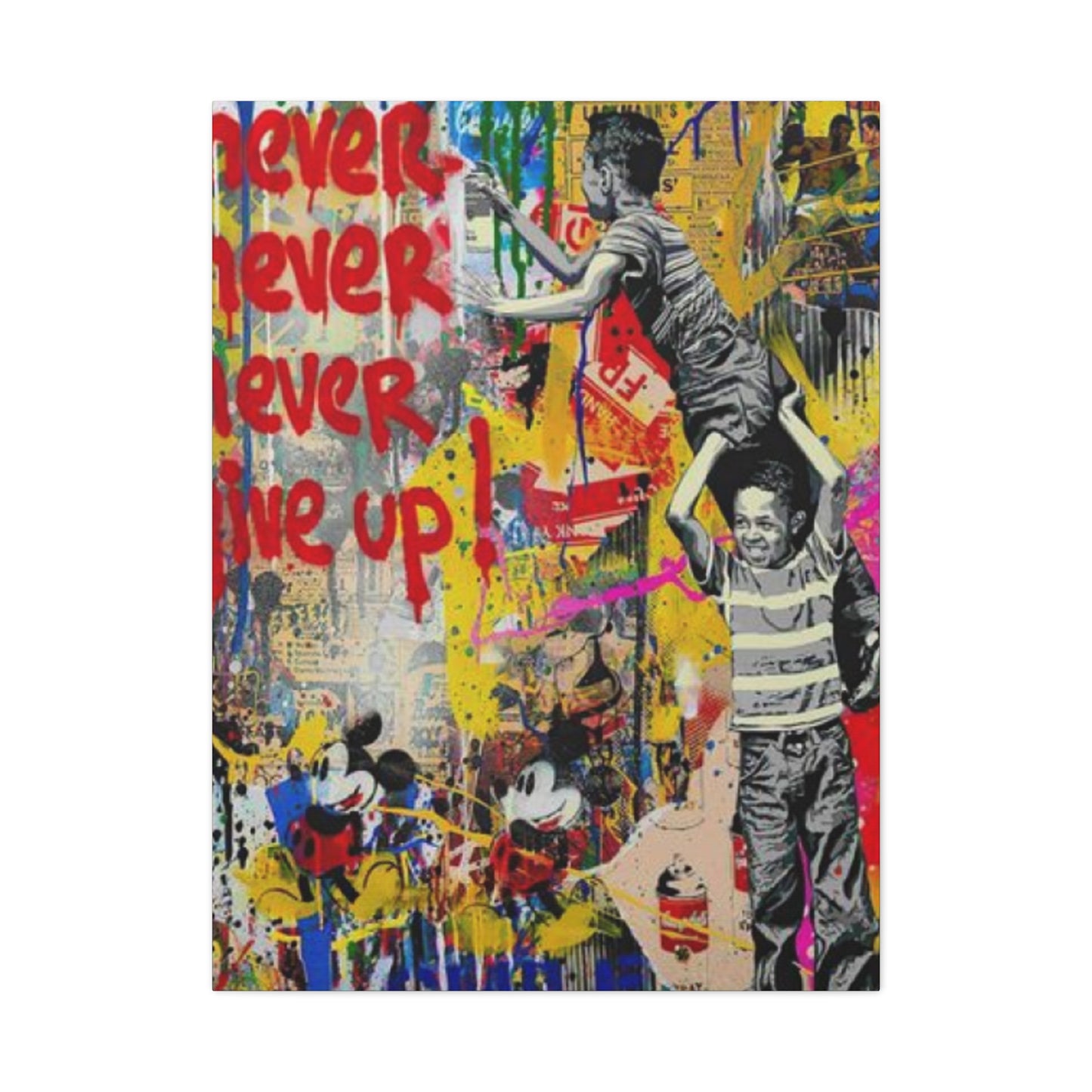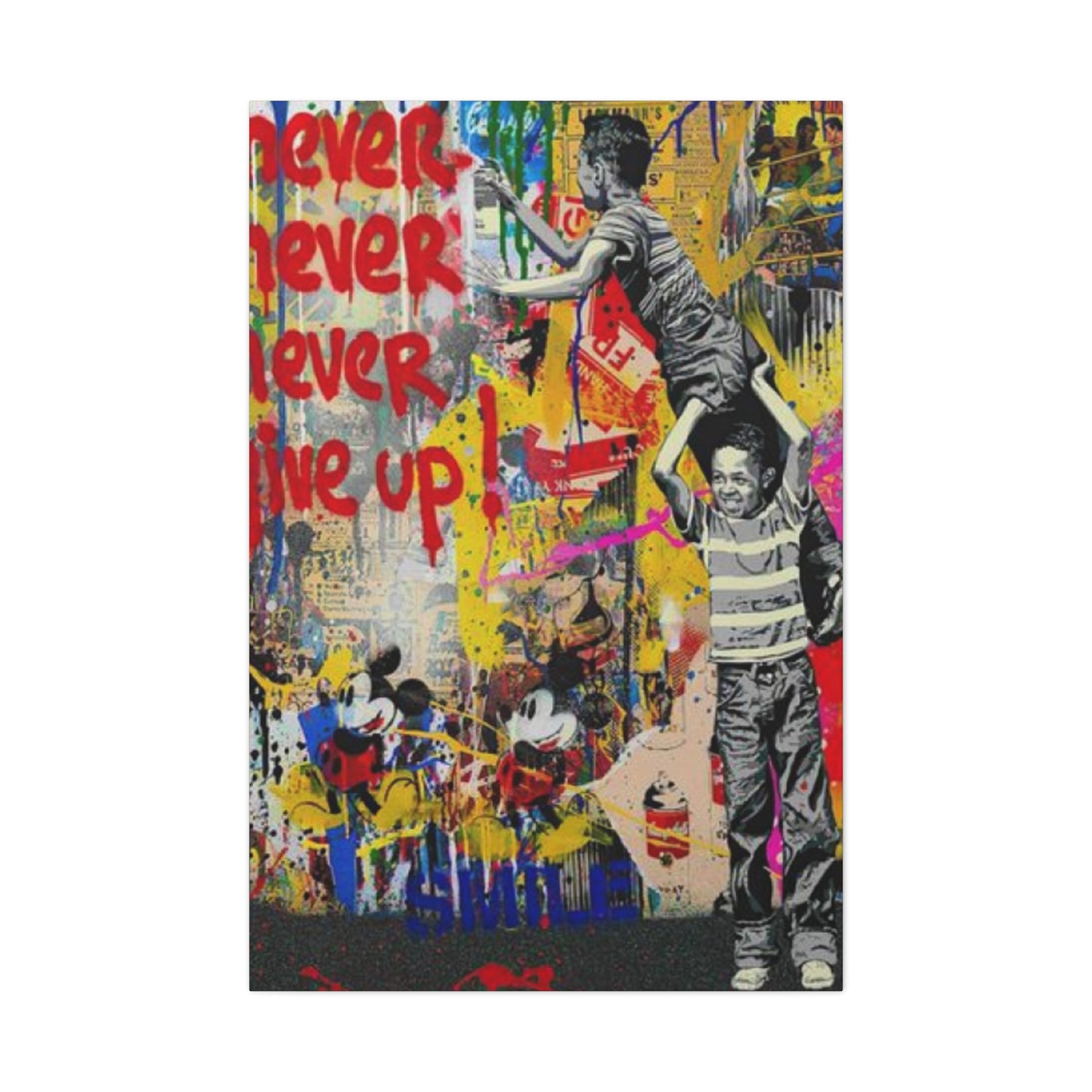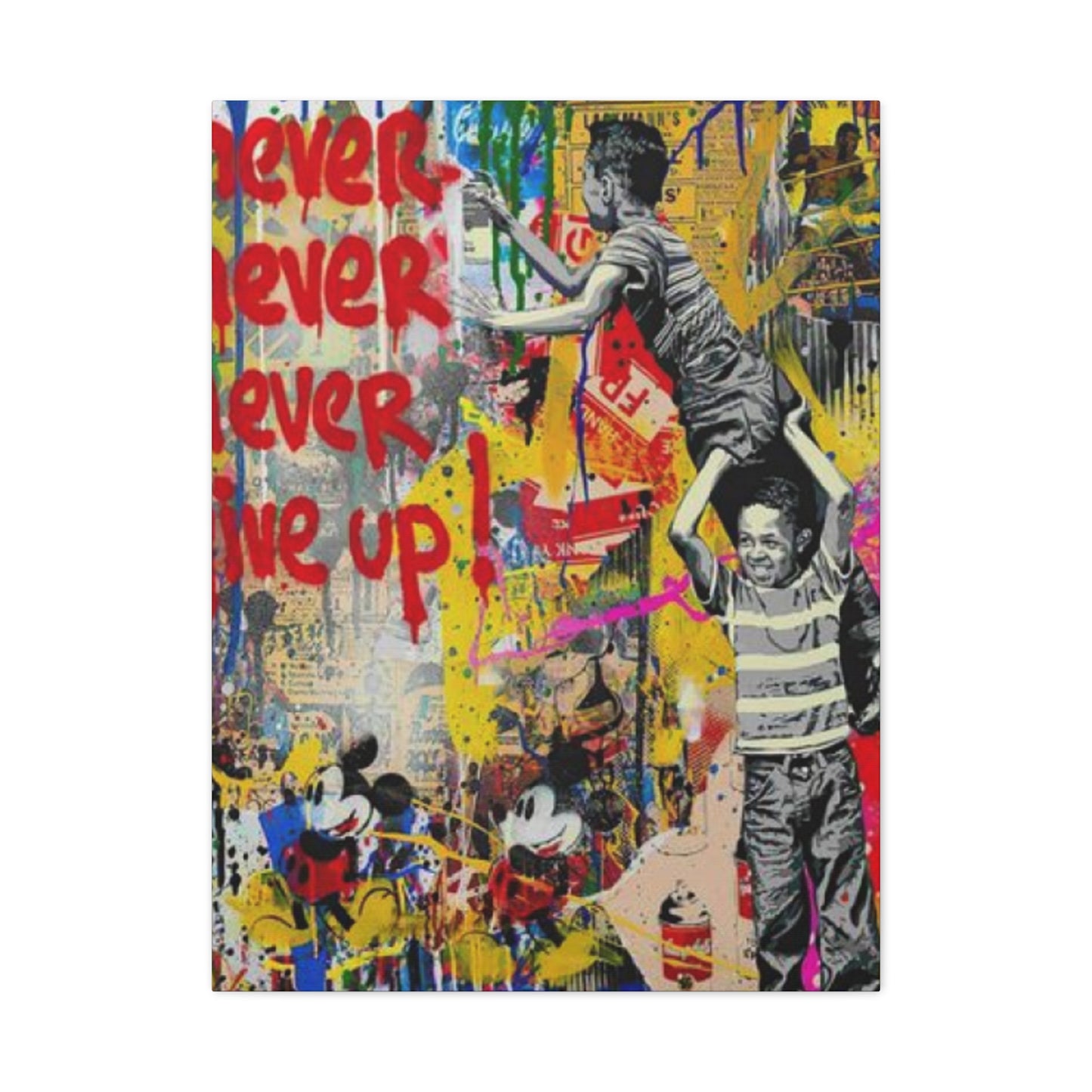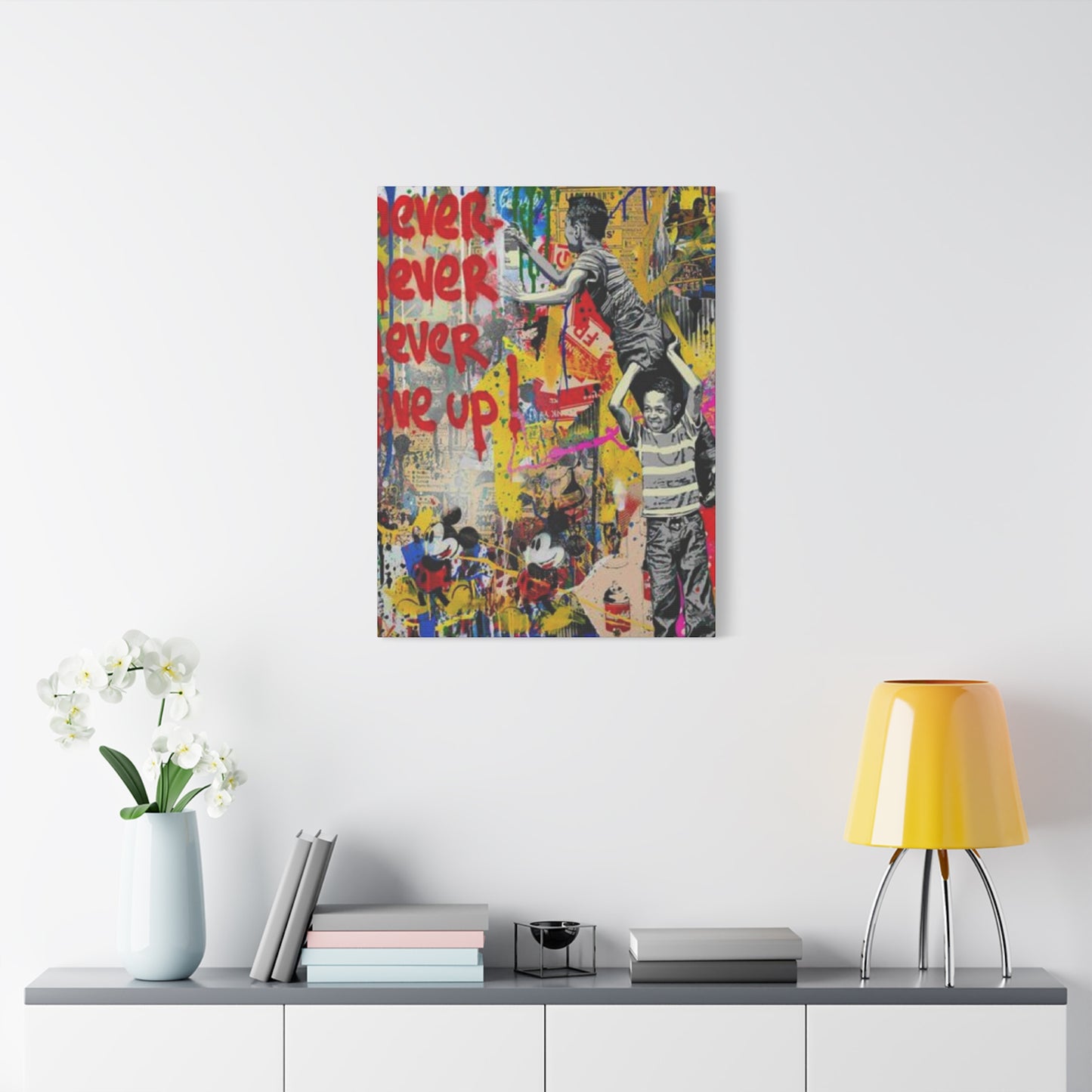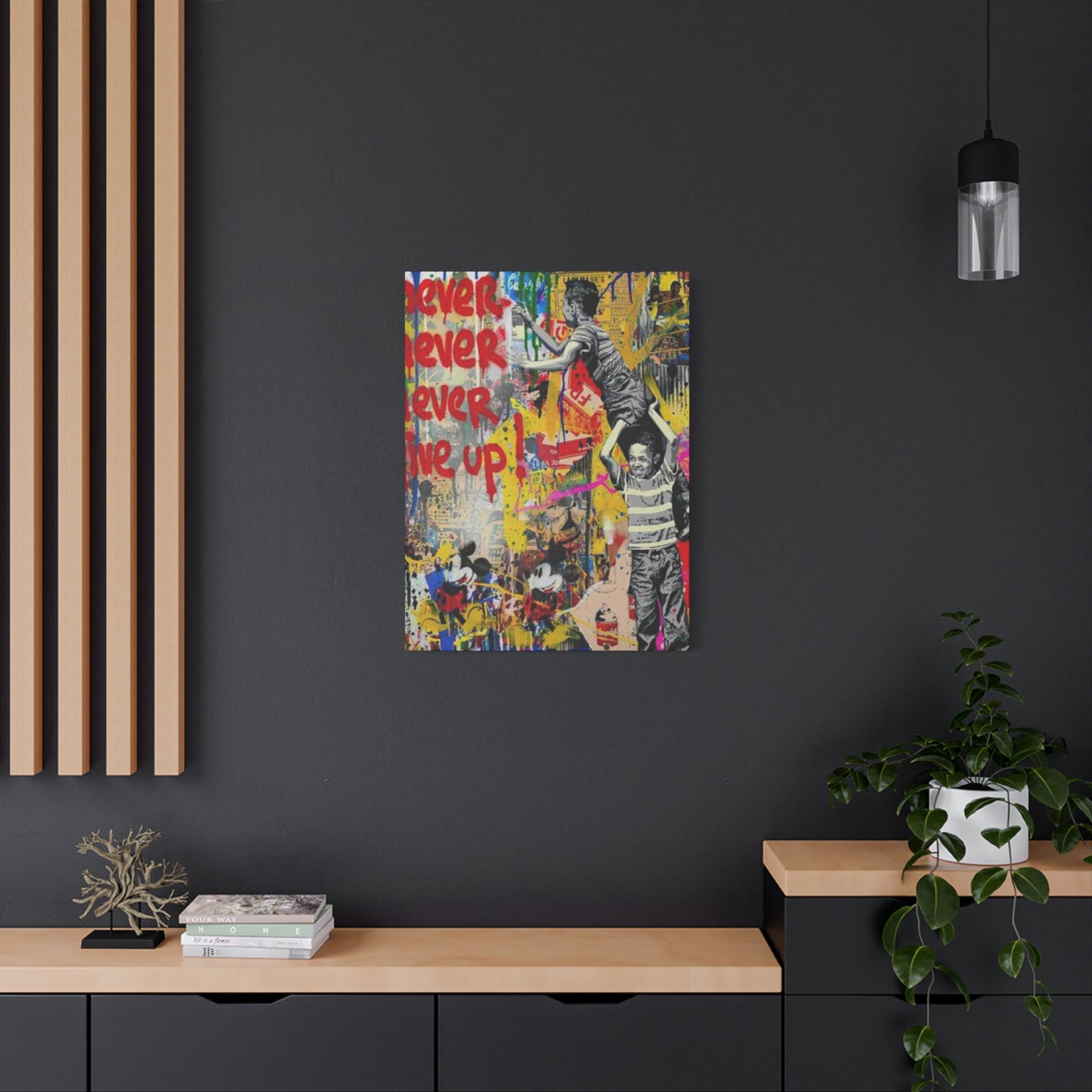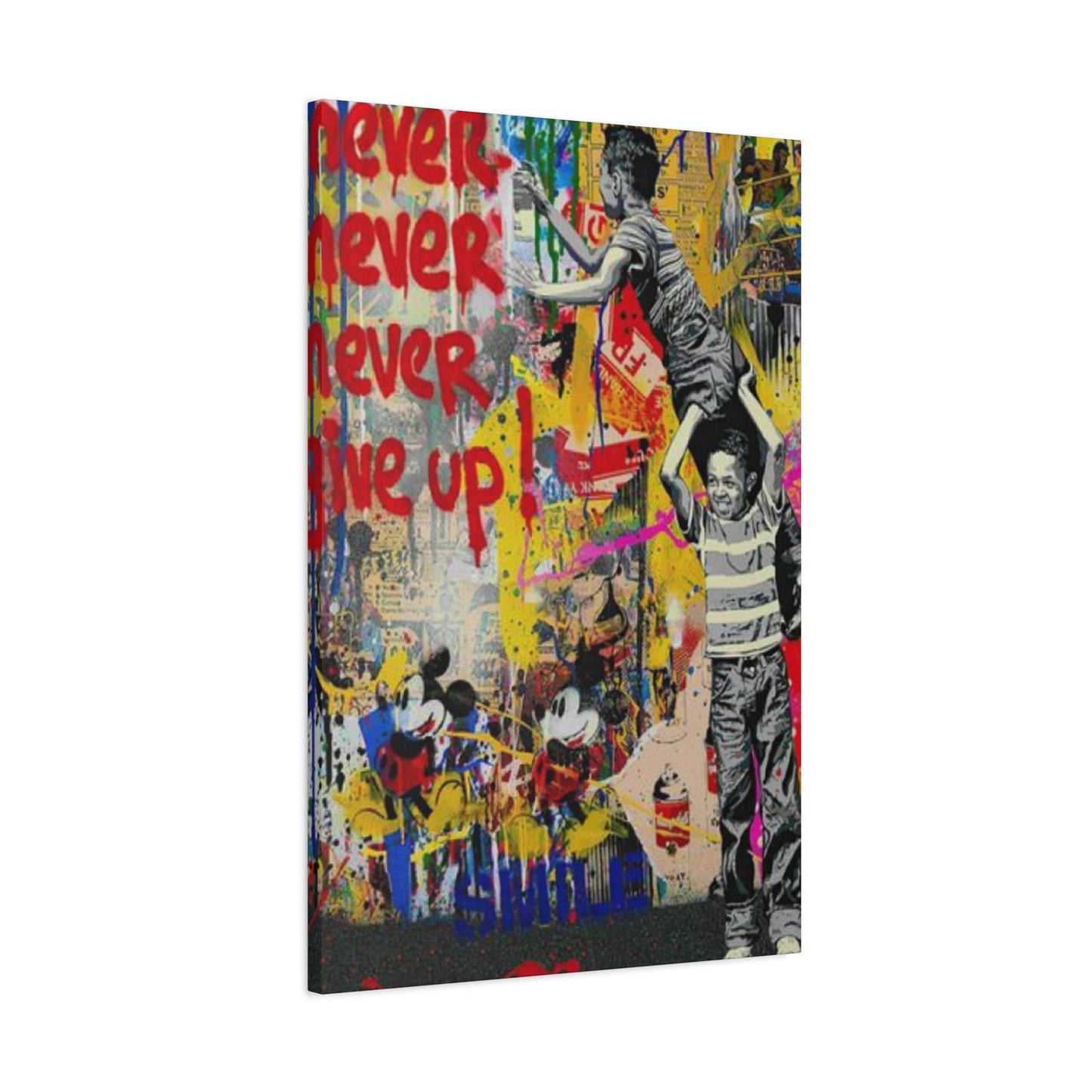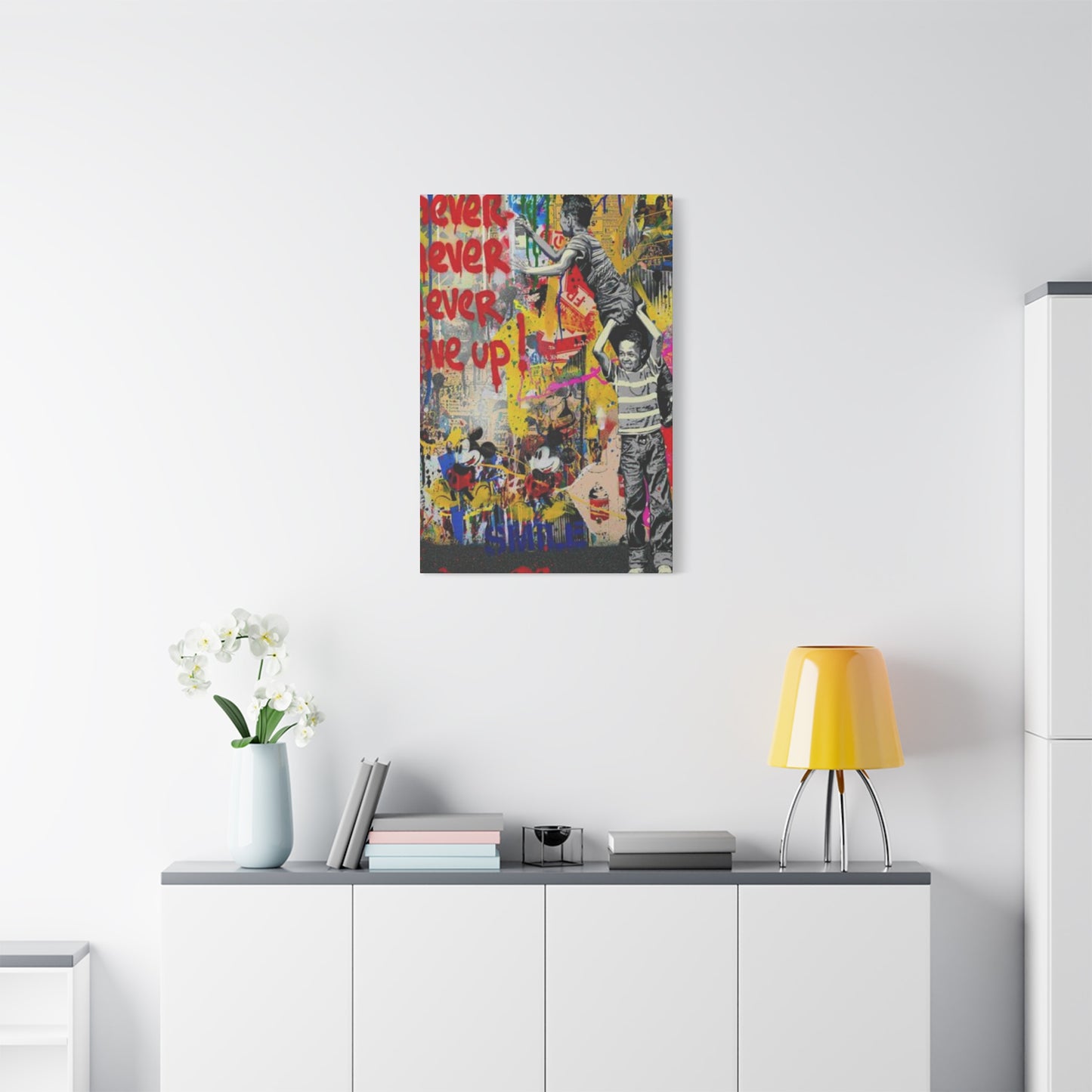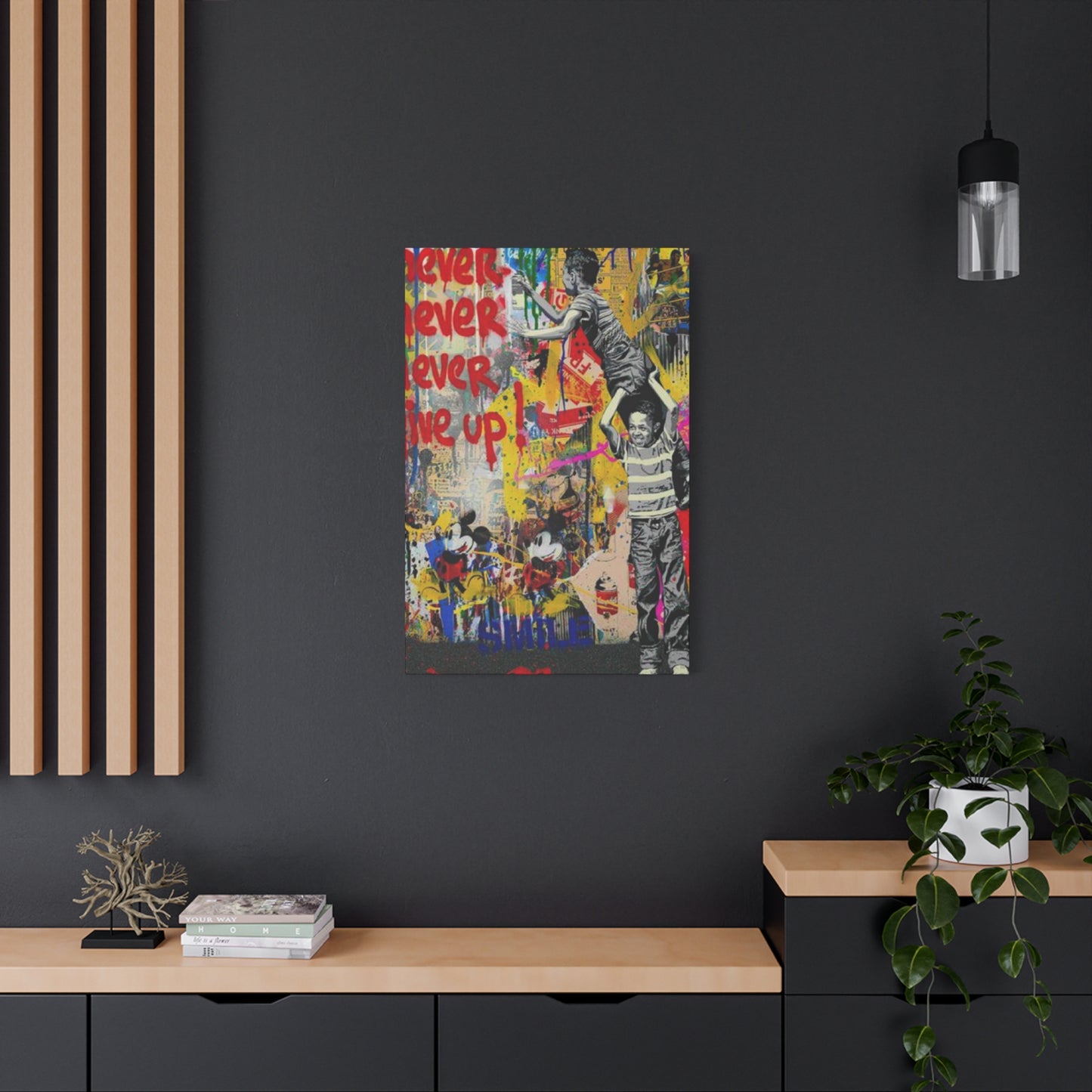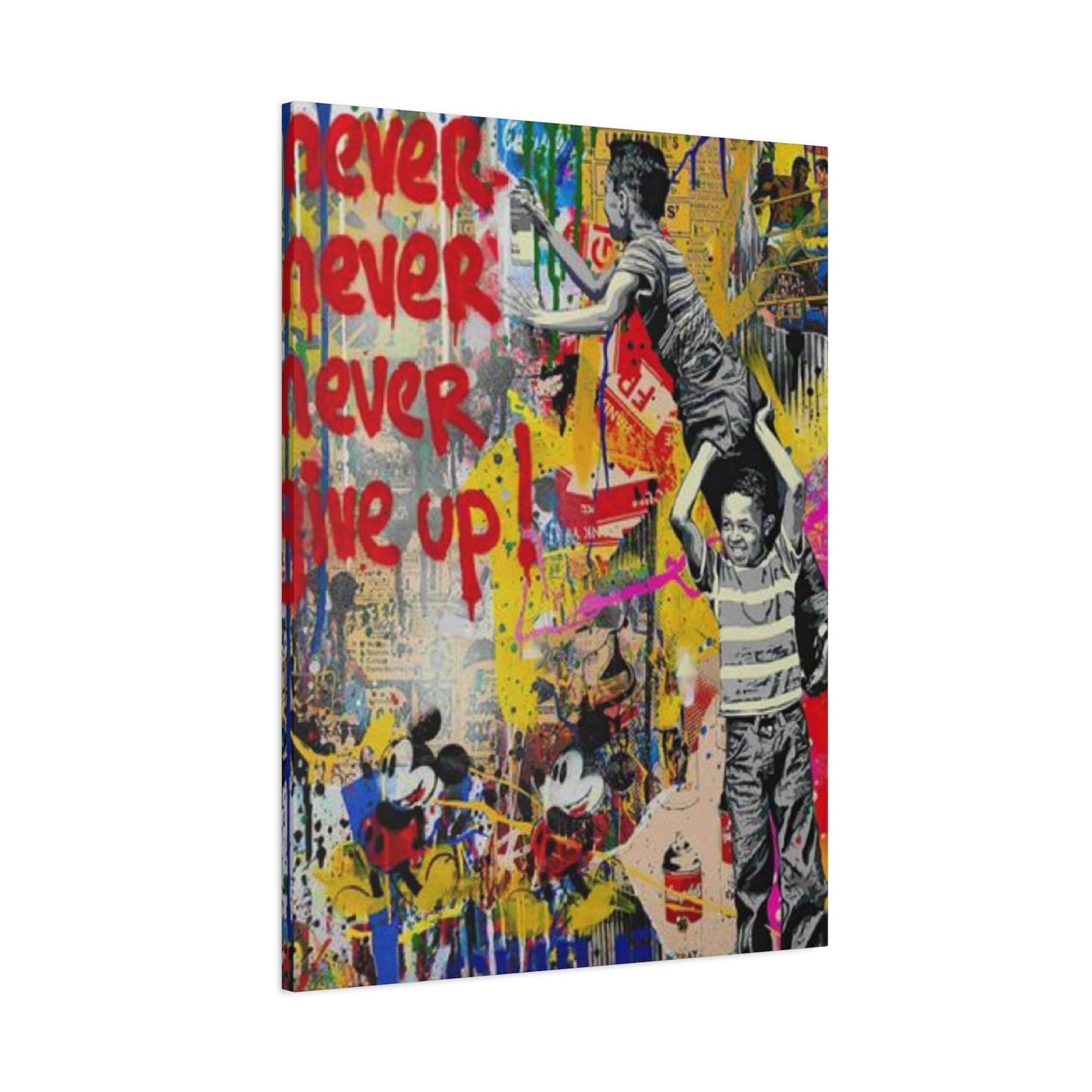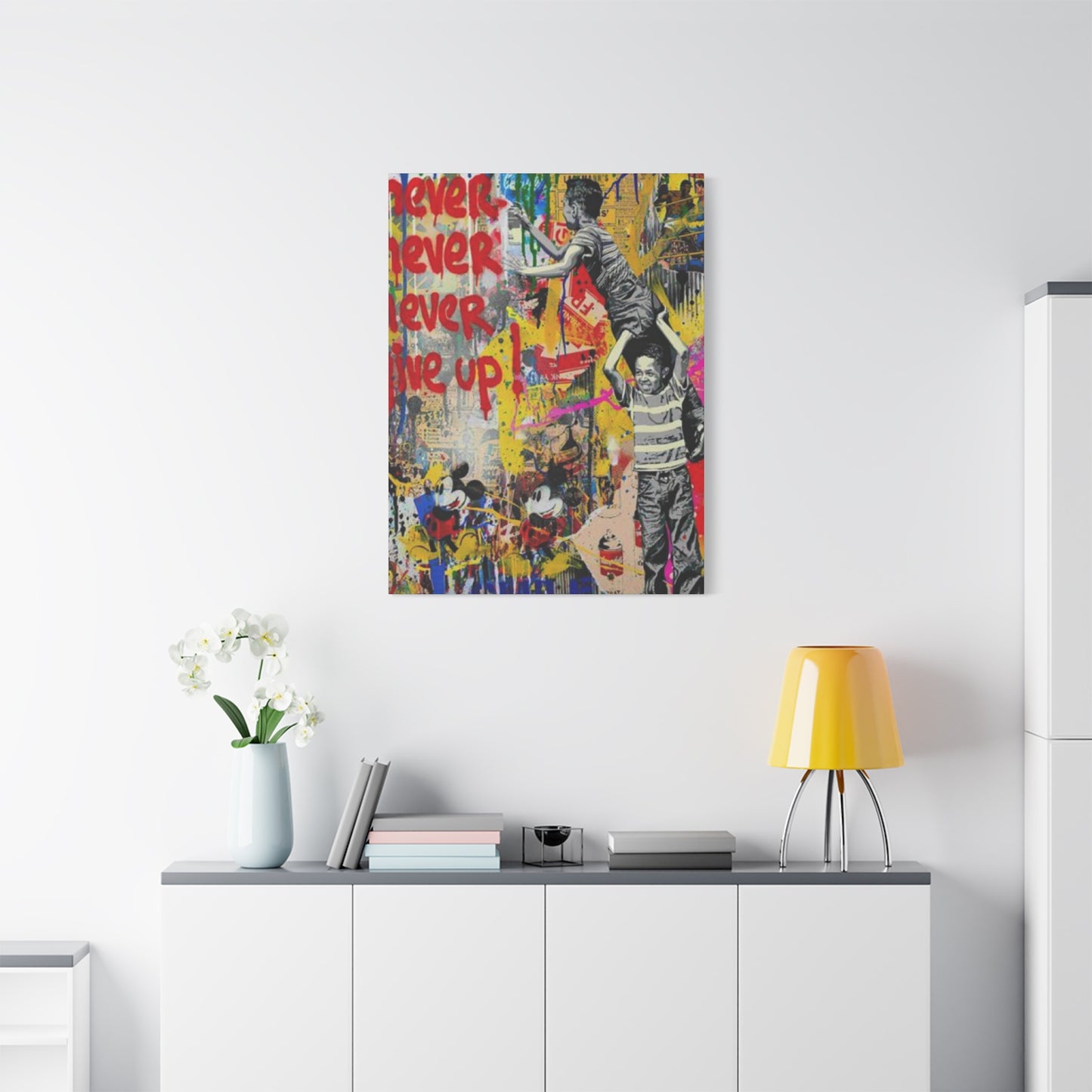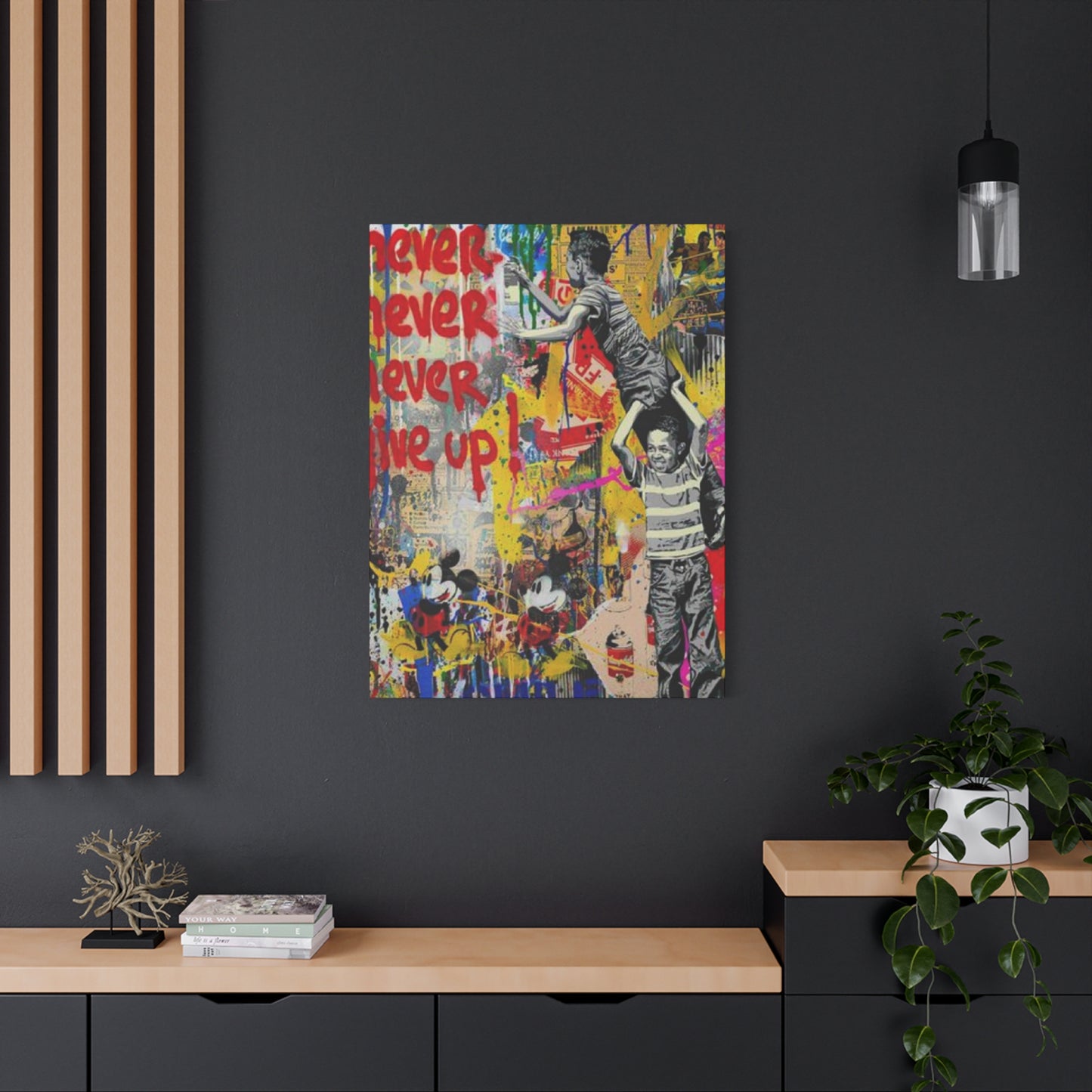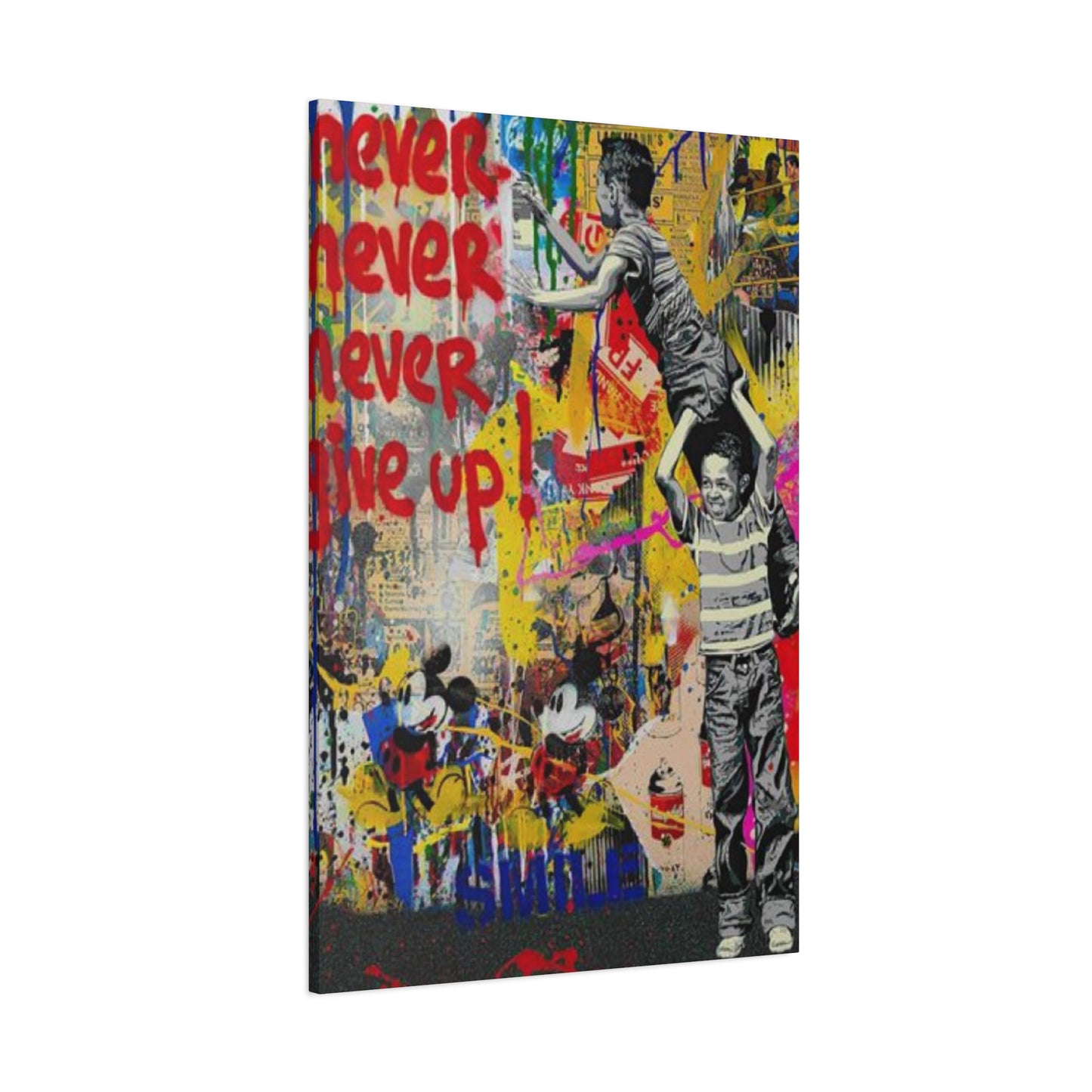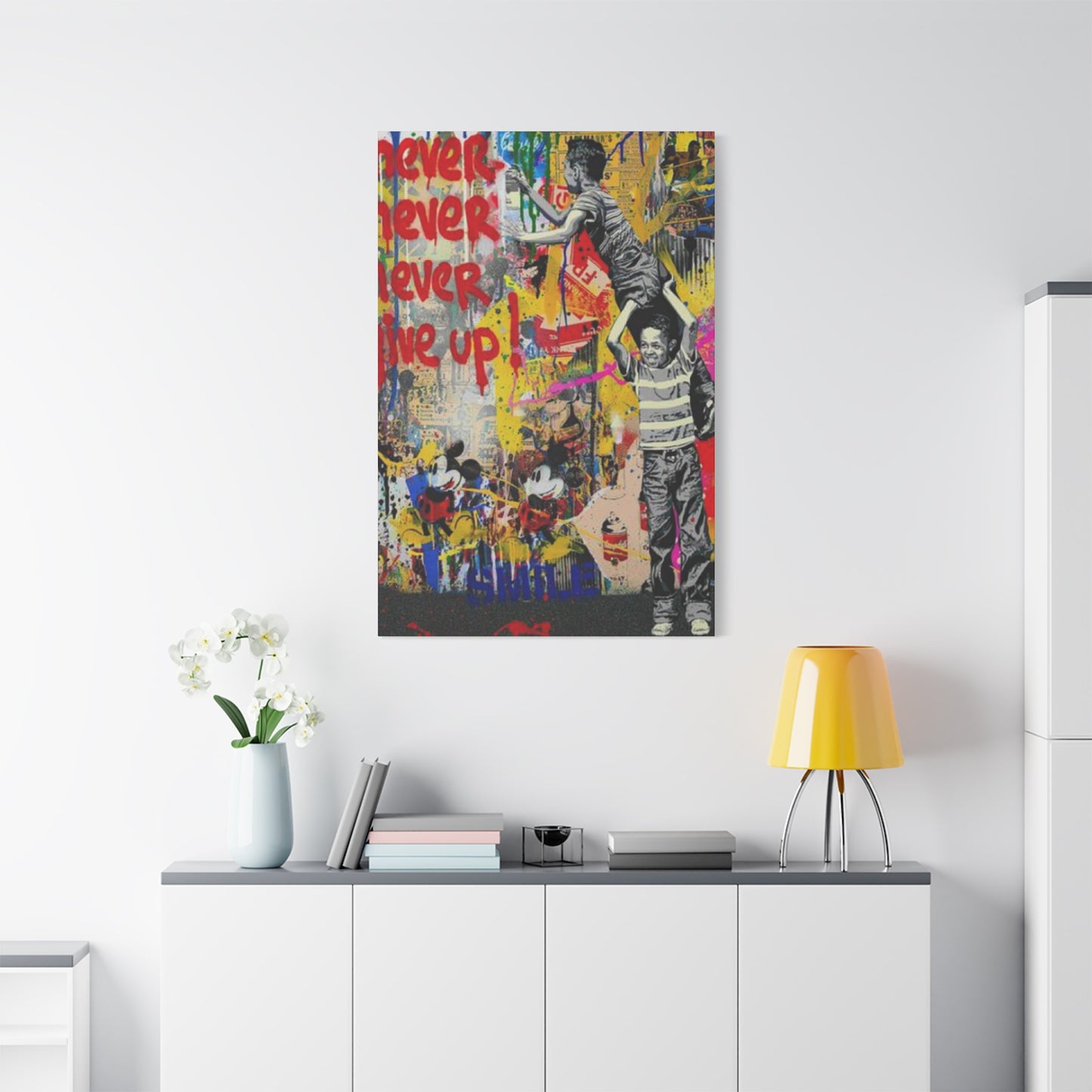Elevate Your Space with Never Give Up Modernism Wall Art
Modernism emerged as a revolutionary artistic movement during the late 19th and early 20th centuries, fundamentally challenging traditional artistic conventions and aesthetic principles. This artistic revolution emphasized innovation, experimentation, and the rejection of historical artistic styles, paving the way for contemporary wall art that continues to influence homes and commercial environments today. Never give up modernism wall art canvas prints represent this enduring legacy, offering homeowners and art enthusiasts an opportunity to incorporate these timeless aesthetic principles into their living environments.
The movement's emphasis on geometric forms, bold color palettes, and abstract compositions has translated beautifully into modern canvas printing technology. Contemporary artists and designers continue to draw inspiration from pioneering modernist masters, creating pieces that honor the movement's core principles while embracing modern production techniques. These canvas prints serve as accessible entry points for individuals seeking to experience the transformative power of modernist aesthetics without the prohibitive costs associated with original artworks.
The significance of modernist wall art extends beyond mere decoration, functioning as a means of cultural expression and philosophical statement. Each piece communicates specific ideas about progress, innovation, and the rejection of outdated conventions. When individuals choose never give up modernism wall art canvas prints, they're making a conscious decision to align themselves with these progressive ideals while creating visually striking focal points within their living environments.
Understanding Canvas Print Technology and Artistic Reproduction
Modern canvas printing technology has revolutionized how we access and display artistic masterpieces, making high-quality reproductions of modernist works more affordable and widely available than ever before. Advanced digital printing processes now capture the subtle nuances of color, texture, and brushwork that define modernist paintings, ensuring that canvas prints maintain the visual impact and emotional resonance of their original counterparts.
The canvas material itself plays a crucial role in the final aesthetic outcome. High-quality canvas substrates provide the texture and dimensional quality that enhances the viewing experience, creating depth and visual interest that flat paper prints cannot achieve. Professional-grade canvas materials are designed to withstand environmental factors such as humidity, temperature fluctuations, and ultraviolet light exposure, ensuring longevity and color stability over time.
Printing techniques have evolved to accommodate various artistic styles and color requirements. Modern inkjet technology utilizes archival-quality inks that resist fading and maintain color accuracy for decades. The printing process can reproduce fine details, subtle gradations, and bold contrasts that characterize modernist artwork, making it possible for consumers to enjoy museum-quality reproductions in their own homes.
Finishing techniques further enhance the professional appearance of canvas prints. Gallery wrapping, where the canvas is stretched around wooden frames and secured on the back, creates a clean, contemporary look that eliminates the need for additional framing. This presentation method allows the artwork to appear as if it's floating on the wall, emphasizing the modernist aesthetic of clean lines and uncluttered presentation.
Selecting Appropriate Modernist Themes for Contemporary Environments
The selection of appropriate modernist themes requires careful consideration of both aesthetic preferences and environmental context. Never give up modernism wall art canvas prints encompass a wide range of stylistic approaches, from abstract expressionism to geometric minimalism, each offering unique visual and emotional qualities that can transform living areas.
Abstract compositions featuring bold geometric shapes, primary colors, and dynamic arrangements work exceptionally well in contemporary settings. These pieces create visual focal points while maintaining the clean, uncluttered aesthetic that defines modern living. The interplay of shapes and colors can energize a room while providing sophisticated visual interest that encourages contemplation and discussion.
Minimalist modernist approaches emphasize simplicity, negative planes, and subtle color relationships. These works complement environments where tranquility and sophistication are prioritized. The understated nature of minimalist pieces allows them to integrate seamlessly into various decorative schemes while providing subtle visual anchors that enhance rather than overwhelm the surrounding environment.
Industrial modernist themes incorporate elements inspired by machinery, architecture, and urban landscapes. These compositions often feature metallic color palettes, angular forms, and references to modern manufacturing and construction techniques. Such pieces work particularly well in loft-style living areas, home offices, and contemporary kitchens where the industrial aesthetic is already established.
Organic modernism represents another significant category, featuring flowing forms, natural color palettes, and references to landscape and botanical subjects. These works bridge the gap between modernist artistic principles and natural world inspiration, creating pieces that feel both contemporary and timeless. The organic approach works well in bedroom areas, meditation rooms, and other environments where relaxation and connection to nature are desired.
Color Psychology and Modernist Wall Art Applications
Color psychology plays a fundamental role in how modernist wall art affects mood, energy levels, and overall environmental atmosphere. Never give up modernism wall art canvas prints utilize color strategically to create specific emotional responses and enhance the psychological comfort of living areas. Understanding these color relationships enables more informed selection decisions that align with intended environmental goals.
Bold primary colors characteristic of many modernist works can energize and stimulate activity. Red, blue, and yellow combinations create dynamic visual relationships that can enhance creativity and social interaction. These color schemes work exceptionally well in areas designated for entertaining, creative work, or active family gatherings. The psychological impact of these colors can increase alertness and promote engaging conversation among occupants and guests.
Neutral color palettes featuring blacks, whites, grays, and earth tones create calming, sophisticated environments that promote relaxation and contemplation. These subtle color relationships allow other environmental elements to take prominence while providing visual stability and timeless appeal. Neutral modernist pieces work well in bedroom areas, reading nooks, and professional environments where concentration and tranquility are priorities.
Monochromatic color schemes explore various shades and tints of single hues, creating sophisticated visual relationships that emphasize form, texture, and composition over color contrast. These approaches can create meditative, harmonious environments that promote focus and reduce visual distraction. Monochromatic modernist works are particularly effective in minimalist environments where simplicity and elegance are paramount.
Analogous color relationships, featuring colors that sit adjacent to each other on the color wheel, create harmonious, flowing visual experiences. These color combinations can evoke natural phenomena such as sunsets, ocean waves, or seasonal transitions. Analogous color schemes in modernist wall art create environments that feel connected to natural rhythms while maintaining contemporary aesthetic appeal.
Size Considerations and Proportional Relationships in Wall Art Selection
Proper sizing and proportional relationships are critical factors in successfully integrating never give up modernism wall art canvas prints into living environments. The scale of artwork must harmonize with architectural features, furniture arrangements, and overall room proportions to achieve maximum visual impact and aesthetic coherence.
Large-scale modernist pieces can serve as dramatic focal points that anchor entire room compositions. These substantial works demand attention and can transform otherwise ordinary areas into sophisticated artistic environments. When selecting large pieces, consideration must be given to wall dimensions, ceiling height, and viewing distances to ensure the artwork can be appreciated properly without overwhelming the environment.
Medium-sized pieces offer versatility and can be used individually or in groupings to create dynamic wall arrangements. These dimensions work well above furniture pieces such as sofas, credenzas, or beds, where they can complement existing furniture proportions while providing visual interest. Medium-sized modernist works can also be grouped in various configurations to create gallery-style wall installations.
Small-scale pieces allow for intimate artistic experiences and can be used to create detailed, layered wall arrangements. These works are particularly effective when displayed in groups or series, where relationships between individual pieces create larger compositional statements. Small modernist pieces work well in hallways, powder rooms, and other areas where close viewing is natural and expected.
The concept of visual weight must also be considered when selecting sizes. Bold, high-contrast modernist pieces may appear visually heavier than their actual dimensions suggest, requiring more wall area to achieve proper balance. Conversely, subtle, low-contrast pieces may appear lighter and can be sized proportionally larger without creating visual overwhelm.
Creating Gallery Wall Arrangements with Modernist Canvas Prints
Gallery wall arrangements offer opportunities to display multiple never give up modernism wall art canvas prints in cohesive, visually engaging compositions that can transform entire wall areas into artistic statements. The key to successful gallery arrangements lies in balancing individual piece characteristics while creating unified overall compositions.
Symmetrical arrangements create formal, balanced compositions that work well in traditional or formal environments. These layouts typically feature identical or similar-sized pieces arranged in regular patterns such as grids or linear sequences. Symmetrical gallery walls provide visual stability and can make bold modernist works feel more approachable and integrated into conservative decorative schemes.
Asymmetrical arrangements offer more dynamic, contemporary approaches that emphasize visual movement and creative expression. These compositions can incorporate pieces of various sizes, creating rhythm and visual flow that guides the eye through the arrangement. Asymmetrical layouts require more careful planning to achieve balance while maintaining the energy and spontaneity that characterize modernist aesthetics.
Color coordination plays a crucial role in gallery wall success. Pieces can be unified through shared color palettes, creating harmonious relationships that tie individual works together. Alternatively, controlled color contrasts can create dynamic visual relationships that energize the overall composition while maintaining coherent artistic statements.
Spacing considerations significantly impact the visual effectiveness of gallery arrangements. Consistent spacing between pieces creates orderly, professional appearances suitable for formal environments. Varied spacing can create more organic, casual arrangements that feel spontaneous and personally curated. The spacing should be proportional to both the artwork dimensions and the viewing distance from the wall.
Theme consistency helps create cohesive gallery walls that feel intentional rather than random. This might involve selecting pieces from the same artistic period, featuring similar subject matter, or sharing compositional approaches. Thematic coherence allows individual pieces to support and enhance each other while creating stronger overall artistic statements.
Lighting Techniques for Modernist Wall Art Enhancement
Proper lighting dramatically influences how never give up modernism wall art canvas prints are perceived and appreciated. Effective lighting can enhance colors, emphasize textures, and create atmospheric qualities that amplify the emotional impact of modernist works. Understanding various lighting approaches enables optimal presentation of these artistic investments.
Natural lighting provides the most accurate color rendition and creates dynamic viewing experiences that change throughout the day. Positioning modernist wall art to take advantage of natural light requires consideration of sun angles, window orientations, and potential glare issues. North-facing walls typically receive consistent, even natural light that minimizes color distortion and provides stable viewing conditions throughout the day.
Artificial lighting offers greater control over intensity, color temperature, and directional qualities. LED track lighting systems provide flexible options for highlighting individual pieces or creating even illumination across gallery wall arrangements. The adjustable nature of track systems allows for modifications as artwork arrangements change or as viewing preferences evolve.
Picture lighting involves dedicated fixtures mounted above or beside individual artworks to provide focused illumination. These fixtures can be hardwired or plug-in varieties, depending on electrical access and aesthetic preferences. Picture lights work particularly well for highlighting significant pieces or creating intimate viewing experiences in areas with limited ambient lighting.
Accent lighting techniques can create dramatic presentations that emphasize the sculptural qualities of canvas prints. Grazing light across textured canvas surfaces can reveal subtle details and create visual depth that enhances the modernist emphasis on form and materiality. Carefully positioned accent lights can transform flat wall surfaces into dynamic, three-dimensional artistic environments.
Color temperature considerations affect how colors within modernist works are perceived. Warm lighting (2700-3000K) can enhance red and yellow tones while potentially dulling blues and greens. Cool lighting (4000-5000K) provides more neutral color rendition that may be preferable for works featuring diverse color palettes. Adjustable color temperature fixtures offer the flexibility to optimize lighting for specific artworks or viewing preferences.
Preservation of Canvas Print Investments
Proper maintenance and preservation practices ensure that never give up modernism wall art canvas prints retain their visual appeal and structural integrity over time. Understanding appropriate care techniques protects these artistic investments while maximizing their longevity and continued enjoyment.
Environmental conditions significantly impact canvas print durability. Stable temperature and humidity levels prevent canvas expansion and contraction that can lead to cracking or warping. Ideal conditions typically involve temperatures between 65-75°F and relative humidity levels of 45-55%. Avoiding locations near heating vents, fireplaces, or areas with frequent temperature fluctuations helps maintain optimal preservation conditions.
Direct sunlight exposure can cause fading and color shifts in canvas prints over time. While modern archival inks offer improved lightfastness compared to earlier printing technologies, prolonged exposure to intense sunlight should still be minimized. Positioning artwork away from direct sun rays or using window treatments to filter UV light helps preserve color accuracy and vibrancy.
Regular cleaning maintains the appearance of canvas prints while preventing dust and pollutant accumulation. Gentle dusting with soft, dry brushes or microfiber cloths removes surface debris without damaging the printed surface. Avoid using liquid cleaners, compressed air, or aggressive cleaning materials that could damage the canvas texture or printed imagery.
Handling procedures should minimize direct contact with printed surfaces. When moving or adjusting canvas prints, handle them by the frame edges rather than touching the printed areas. Clean hands prevent oil and dirt transfer that could create permanent staining or discoloration over time.
Professional conservation services may be appropriate for valuable or irreplaceable pieces that show signs of damage or deterioration. Conservation professionals can address issues such as canvas tears, color fading, or structural problems using specialized techniques and materials designed to preserve artistic integrity while extending useful life.
Integration with Contemporary Furniture and Architectural Elements
Successfully integrating never give up modernism wall art canvas prints with contemporary furniture and architectural elements requires understanding how artistic pieces interact with their surrounding environments. This integration goes beyond simple placement to create cohesive design narratives that enhance both the artwork and the living environment.
Furniture scale relationships influence how wall art is perceived and appreciated. Large furniture pieces can support proportionally larger artworks, creating balanced compositions that feel intentional and professionally designed. Conversely, delicate furniture pieces may be overwhelmed by oversized artworks, requiring more modest-scaled pieces that complement rather than compete with existing furnishings.
Color coordination between artwork and furniture creates harmonious environments that feel unified and thoughtfully composed. This doesn't require exact color matching but rather the establishment of color relationships that support and enhance each element. Modernist art's often bold color palettes can serve as inspiration for accent colors in textiles, accessories, or smaller furniture pieces.
Material relationships offer opportunities to create sophisticated design narratives that connect various environmental elements. For example, the industrial themes common in modernist art might be echoed through metal furniture accents, exposed architectural elements, or contemporary lighting fixtures. These material connections create design coherence while allowing individual elements to maintain their distinct characteristics.
Architectural features such as built-in shelving, mantels, or alcoves provide natural frameworks for displaying modernist wall art. These features can create intimate gallery areas that showcase artwork while integrating it into the architectural fabric of the room. Understanding how to work with existing architectural elements enhances both the artwork presentation and the overall environmental design.
Contemporary architectural trends toward open floor plans create opportunities for artwork to serve as visual dividers or transitional elements between functional areas. Large modernist pieces can define living areas, dining areas, or work areas within open concepts while maintaining the visual flow that makes these layouts appealing.
Modernist Aesthetics in Living Environments
The psychological impact of never give up modernism wall art canvas prints extends beyond simple aesthetic appreciation to influence mood, behavior, and overall environmental satisfaction. Understanding these psychological effects enables more informed selection decisions that support desired lifestyle goals and emotional well-being.
Modernist emphasis on clean lines, geometric forms, and uncluttered compositions can create calming, organized environments that reduce stress and promote mental clarity. The visual order inherent in many modernist works can provide psychological relief from the chaos and complexity of daily life, creating sanctuary areas that support relaxation and contemplation.
The bold, confident nature of modernist aesthetics can inspire similar psychological states in viewers. Exposure to artworks that embody principles of innovation, progress, and creative expression can encourage similar attitudes and behaviors. This inspirational quality makes modernist wall art particularly appropriate for work areas, creative studios, or other environments where motivation and forward-thinking are valued.
Color psychology within modernist contexts can be leveraged to create specific emotional atmospheres. The strategic use of energizing colors can stimulate activity and social interaction, while calming color relationships can promote rest and introspection. Understanding these color effects enables the creation of environments that support desired activities and emotional states.
The intellectual nature of modernist art can stimulate cognitive engagement and promote creative thinking. Abstract compositions encourage viewers to interpret meaning and create personal connections with the artwork, exercises that can enhance cognitive flexibility and creative problem-solving abilities. This mental stimulation makes modernist pieces valuable additions to environments where intellectual work occurs.
Cultural associations with modernist aesthetics can communicate personal values and aesthetic sensibilities to others. Choosing modernist wall art sends messages about appreciation for innovation, quality, and sophisticated aesthetic judgment. These cultural communications can enhance professional environments or social areas where making positive impressions is important.
Budget Considerations and Value Optimization in Canvas Print Selection
Making informed financial decisions when selecting never give up modernism wall art canvas prints requires understanding various factors that influence both initial costs and long-term value. Developing strategies for budget optimization ensures that artistic investments provide maximum satisfaction while remaining within financial parameters.
Print quality directly impacts both visual appeal and longevity, making it a crucial factor in value consideration. Higher-quality printing processes, archival inks, and professional-grade canvas materials typically command premium prices but provide superior visual results and extended lifespans. Understanding the relationship between quality and cost helps determine appropriate investment levels for different applications.
Size considerations significantly impact pricing, with larger pieces generally commanding higher costs due to material usage and printing complexity. However, the cost per square inch typically decreases with larger sizes, making substantial pieces potentially better values for dramatic impact applications. Balancing size desires with budget constraints requires careful consideration of intended placement and visual goals.
Limited edition prints often command premium prices due to their exclusivity and potential collectibility. While these pieces may represent good long-term investments for serious collectors, they may not provide optimal value for individuals primarily interested in aesthetic enhancement rather than investment potential. Understanding personal priorities helps determine whether premium pricing for limited editions is justified.
Framing and presentation options significantly impact total project costs. Gallery wrapping eliminates the need for additional framing while creating professional presentations suitable for most environments. Traditional framing adds costs but provides additional customization options and potential protection benefits. Evaluating presentation requirements helps determine optimal cost allocation between print quality and framing investments.
Volume purchasing can provide cost advantages when creating gallery wall arrangements or decorating multiple rooms. Many suppliers offer discounts for multiple piece orders, making comprehensive decorating projects more affordable. Planning comprehensive artwork needs enables better negotiation of favorable pricing arrangements.
Custom Design Options and Personalization Opportunities
Custom design options for never give up modernism wall art canvas prints offer opportunities to create unique pieces that perfectly match personal aesthetic preferences and environmental requirements. Understanding available customization possibilities enables the creation of truly personalized artistic statements that reflect individual tastes and values.
Size customization allows pieces to be created in dimensions that perfectly fit intended locations and proportional requirements. This flexibility eliminates the compromise often necessary when selecting from standard size offerings and ensures optimal integration with existing furniture and architectural elements. Custom sizing is particularly valuable for unusual wall dimensions or specific design requirements.
Color modification services can adjust artwork palettes to better coordinate with existing decorative schemes. Professional color manipulation can enhance specific hues, adjust overall saturation levels, or create monochromatic variations of originally colorful pieces. These modifications allow greater flexibility in matching personal preferences while maintaining the essential character of modernist compositions.
Cropping and composition adjustments enable focus on specific areas of larger works or the creation of detail studies that emphasize particular elements. This approach can transform single large compositions into multiple related pieces suitable for gallery wall arrangements or series installations. Custom cropping also allows adaptation of horizontal compositions for vertical display areas or vice versa.
Text integration offers opportunities to incorporate meaningful quotes, personal mottos, or inspirational messages into modernist compositions. Careful typography selection and placement can enhance the artistic impact while adding personal significance to the pieces. This customization option is particularly popular for motivational artwork intended for office or studio environments.
Original artwork creation services combine modernist aesthetic principles with completely personalized content. These services work with individual clients to create unique pieces that incorporate specific themes, color preferences, or symbolic elements while maintaining the essential characteristics of modernist design. Original creations ensure complete uniqueness while providing artistic pieces that perfectly match personal requirements.
Digital Art Revolution and Modern Canvas Printing Applications
The digital art revolution has fundamentally transformed how never give up modernism wall art canvas prints are created, distributed, and consumed. Understanding these technological developments provides insight into current possibilities and future trends that will continue to expand artistic options and accessibility.
Digital creation tools enable contemporary artists to explore modernist principles using sophisticated software applications that provide unprecedented control over color, form, and composition. These tools allow for precise geometric constructions, complex color relationships, and experimental techniques that would be difficult or impossible to achieve through traditional media. The result is a new generation of modernist-inspired works that honor historical principles while embracing contemporary possibilities.
Print-on-demand technology has revolutionized artwork distribution by eliminating inventory requirements and enabling cost-effective production of single pieces or small quantities. This technology makes it possible for artists and retailers to offer extensive catalogs without significant upfront investments, resulting in greater variety and more competitive pricing for consumers.
Color management systems ensure accurate color reproduction across different devices and printing systems. Advanced color profiling techniques allow artists and printers to maintain consistent color relationships from digital creation through final printed output. This precision ensures that canvas prints accurately represent artistic intentions while maintaining the color relationships essential to modernist compositions.
Variable data printing enables mass customization options that allow individual modifications to base designs. This technology makes it possible to offer personalized elements such as custom text, modified color schemes, or adjusted compositions without requiring completely custom design services. Variable printing capabilities expand personalization options while maintaining cost effectiveness.
Augmented reality applications allow potential buyers to visualize how canvas prints will appear in their actual environments before making purchase decisions. These technologies use smartphone cameras to overlay digital artwork images onto real wall locations, providing accurate previews of size, color, and compositional relationships. AR visualization reduces uncertainty and increases confidence in selection decisions.
Considerations and Sustainable Printing Practices
Environmental consciousness increasingly influences purchasing decisions for never give up modernism wall art canvas prints. Understanding sustainable printing practices and environmental considerations enables more responsible artistic investments that align with ecological values while maintaining aesthetic and quality standards.
Eco-friendly ink formulations reduce environmental impact while maintaining color quality and archival stability. Water-based and soy-based ink systems eliminate harmful solvents and volatile organic compounds that can affect both environmental and indoor air quality. These ink alternatives often provide excellent color reproduction while supporting healthier manufacturing processes.
Sustainable canvas materials include options made from renewable resources, recycled content, or responsibly managed forestry operations. Bamboo-based canvases offer excellent printing surfaces while utilizing rapidly renewable resources. Recycled content canvases reduce waste streams while providing suitable substrates for high-quality printing applications.
Local production reduces transportation-related environmental impacts while supporting regional economies. Choosing locally produced canvas prints minimizes shipping distances and associated carbon footprints while often providing opportunities for direct artist or producer relationships. Local sourcing also enables easier inspection of production practices and quality standards.
Packaging considerations include minimizing material usage and selecting recyclable or biodegradable packaging materials. Efficient packaging design reduces shipping volumes and associated environmental costs while providing adequate protection for artwork during transit. Some producers offer minimal packaging options for environmentally conscious consumers.
End-of-life disposal considerations involve selecting materials and construction methods that facilitate recycling or responsible disposal when artwork eventually reaches the end of its useful life. Canvas prints constructed with separable materials allow for more effective recycling of individual components compared to laminated or permanently bonded constructions.
Integration and Smart Home Applications
Modern technology integration offers exciting possibilities for enhancing never give up modernism wall art canvas prints through smart home applications and interactive features. These technological enhancements can transform static artwork into dynamic, responsive elements that adapt to changing preferences and environmental conditions.
Smart lighting systems can be programmed to automatically adjust illumination based on time of day, ambient light levels, or specific viewing preferences. These systems can enhance color reproduction during different periods, create dramatic evening presentations, or provide optimal viewing conditions for various activities. Integration with voice control systems enables effortless lighting adjustments that optimize artwork presentation.
Digital frame technology enables the display of rotating collections of modernist works through high-resolution screens that mimic traditional canvas appearances. These systems can showcase hundreds of different pieces while maintaining the aesthetic appeal of traditional wall art. Some digital frames specifically designed for artistic display offer color accuracy and resolution comparable to high-quality prints.
Environmental monitoring systems can track conditions that affect canvas print preservation, alerting homeowners to potentially harmful temperature or humidity changes. Smart sensors can provide early warnings of conditions that might damage artwork while enabling proactive environmental control measures. These systems are particularly valuable for protecting valuable or irreplaceable pieces.
Augmented reality applications can provide interactive information about displayed artwork, including artist biographies, historical context, or detailed analysis of artistic techniques. Smartphone or tablet applications can overlay digital information onto physical artworks, creating educational experiences that enhance appreciation and understanding of modernist principles.
Home automation integration enables artwork lighting and environmental controls to coordinate with other smart home systems. Artwork presentation can automatically adjust based on entertainment modes, security settings, or daily routines. This integration creates seamless environmental control that optimizes both artwork presentation and overall home functionality.
Social Significance of Modernist Wall Art
The cultural impact and social significance of never give up modernism wall art canvas prints extend far beyond individual aesthetic choices to reflect broader cultural values and social movements. Understanding these implications provides deeper appreciation for the role of modernist art in contemporary society and personal expression.
Modernist principles of innovation, progress, and rejection of outdated traditions continue to resonate with contemporary audiences facing rapid technological and social change. Displaying modernist wall art can represent alignment with these progressive values while creating connections with historical movements that shaped modern culture. This cultural connection provides meaning beyond simple aesthetic appreciation.
Social signaling through art choices communicates educational background, cultural sophistication, and aesthetic sensibilities to visitors and guests. Modernist wall art, with its intellectual reputation and cultural cachet, can enhance professional credibility and social standing. Understanding these social dynamics enables more strategic selection decisions that support personal and professional goals.
Educational value inherent in modernist artwork can inspire learning about art history, cultural movements, and aesthetic philosophy. Living with modernist pieces provides ongoing opportunities for cultural education and appreciation that can be shared with family members and guests. This educational aspect adds value beyond immediate visual appeal.
International cultural connections emerge through modernist art's global influence and recognition. Many modernist principles transcend cultural boundaries, creating shared aesthetic languages that facilitate cross-cultural communication and understanding. This universality makes modernist wall art appropriate for diverse cultural environments and international contexts.
Historical preservation through reproductions helps maintain cultural memory and ensures that important artistic movements remain accessible to new generations. High-quality canvas prints serve as cultural ambassadors that introduce modernist principles to audiences who might not otherwise encounter them through museums or galleries. This democratization of artistic access supports cultural continuity and education.
Professional Applications and Commercial Environment Integration
Never give up modernism wall art canvas prints offer significant advantages for professional applications and commercial environment integration. Understanding these applications enables business owners and facility managers to leverage artistic elements for improved workplace environments and enhanced business success.
Corporate environments benefit from modernist wall art's associations with innovation, progress, and forward-thinking leadership. Displaying sophisticated artwork can enhance company image while creating more inspiring work environments for employees and more impressive reception areas for clients and visitors. The professional appearance of quality canvas prints provides business advantages while remaining cost-effective compared to original artwork.
Healthcare facilities increasingly recognize the therapeutic benefits of quality artwork in promoting healing and reducing stress. Modernist pieces, with their emphasis on harmony, balance, and visual order, can create calming environments that support patient recovery and staff well-being. The durability and easy maintenance of canvas prints make them particularly suitable for healthcare applications.
Educational institutions can utilize modernist wall art to create inspiring learning environments while providing ongoing exposure to important cultural and artistic concepts. Displaying quality reproductions of significant modernist works provides educational value while creating more sophisticated, engaging classroom and common area environments.
Hospitality applications include hotels, restaurants, and entertainment venues where artwork contributes to atmospheric design and guest experience. Modernist pieces can create distinctive brand identities while providing visual interest that enhances customer satisfaction and loyalty. The flexibility of canvas prints enables easy updates and modifications as business needs evolve.
Retail environments can leverage wall art to create distinctive shopping experiences that differentiate businesses from competitors. Modernist artwork can establish sophisticated brand identities while creating environments that encourage longer visits and higher-value purchases. The relatively modest investment in quality wall art can provide significant returns through enhanced customer experience and brand perception.
Emerging Technologies in Wall Art
Emerging technologies and evolving aesthetic preferences are shaping the future of never give up modernism wall art canvas prints. Understanding these trends provides insight into upcoming possibilities and helps inform current investment decisions that will remain relevant as the field continues to evolve.
Artificial intelligence applications in art creation are generating new possibilities for modernist-inspired works that combine algorithmic precision with creative expression. AI systems trained on historical modernist masterpieces can create original compositions that honor traditional principles while exploring new possibilities impossible through manual creation methods. These technologies expand creative possibilities while maintaining connection to established modernist traditions.
Sustainable material innovations continue to improve environmental performance while maintaining or enhancing quality standards. Bio-based canvas materials, recycled ink formulations, and improved production efficiency reduce environmental impacts while often providing superior performance characteristics. These developments align with growing environmental consciousness while supporting continued industry growth.
Interactive artwork technologies enable static prints to incorporate responsive elements that change based on viewer proximity, ambient conditions, or programmed sequences. These technologies can transform traditional wall art into dynamic, engaging installations that maintain modernist aesthetic principles while incorporating contemporary interactive possibilities.
Personalization technologies enable increasingly sophisticated customization options that allow individual buyers to modify artwork elements while maintaining professional quality standards. Advanced color manipulation, compositional adjustment, and content integration services provide near-custom artwork options at production-level pricing.
Virtual and augmented reality integration offers possibilities for enhanced artwork experience and evaluation. VR applications can provide immersive gallery experiences that contextualize individual pieces within broader modernist movements, while AR applications can overlay additional information or alternative versions onto physical artworks.
Regional Preferences and Cultural Adaptations in Modernist Art
Regional preferences and cultural adaptations influence how never give up modernism wall art canvas prints are selected, displayed, and appreciated across different geographic and cultural contexts. Understanding these variations enables more informed selection decisions that align with local aesthetic preferences and cultural expectations.
North American preferences often emphasize bold, confident compositions that reflect cultural values of innovation and individual expression. Large-scale pieces with dramatic color contrasts and dynamic compositions tend to be popular in residential and commercial applications. The cultural association of modernism with progress and success makes these works appealing for professional environments.
European sensibilities frequently favor more subtle, refined approaches that emphasize sophistication and cultural continuity. Modernist works that reference historical artistic traditions while incorporating contemporary elements tend to be well-received. The deeper historical connection to modernist movements in Europe creates greater appreciation for nuanced artistic references and subtle compositional relationships.
Asian markets increasingly appreciate modernist principles adapted to local aesthetic traditions and cultural values. Works that incorporate modernist geometric principles with references to traditional Asian artistic elements create unique fusion approaches that honor both traditions. The emphasis on harmony and balance common in Asian aesthetics aligns well with many modernist compositional principles.
Urban versus rural preferences often reflect different lifestyle priorities and environmental contexts. Urban environments typically favor bold, energetic pieces that compete successfully with busy, stimulating surroundings. Rural settings may prefer more contemplative, nature-inspired modernist works that complement quieter, more reflective lifestyles.
Generational differences influence preferences for traditional versus contemporary interpretations of modernist principles. Older demographics may prefer pieces that closely reference established modernist masters, while younger audiences often gravitate toward contemporary adaptations that incorporate current technologies and aesthetic trends.
Conclusion
Never give up modernism wall art canvas prints represent far more than simple decorative elements; they embody a continuing dialogue between historical artistic innovation and contemporary aesthetic expression. Throughout this comprehensive exploration, we have examined the multifaceted nature of modernist wall art, from its historical foundations and technological production methods to its psychological impact and cultural significance in today's living environments.
The enduring appeal of modernist aesthetics lies in their fundamental principles of innovation, clarity, and purposeful design. These principles continue to resonate with contemporary audiences seeking authentic artistic expression that transcends temporary trends and superficial decoration. When individuals choose modernist canvas prints, they are participating in a cultural legacy that celebrates creative courage, intellectual rigor, and aesthetic excellence.
The technological revolution in canvas printing has democratized access to high-quality artistic reproductions, making it possible for broader audiences to experience the transformative power of modernist art in their daily environments. Advanced printing techniques now capture the subtle nuances and bold statements that define modernist masterpieces, ensuring that reproductions maintain the emotional impact and visual sophistication of their original counterparts.
The integration of modernist wall art into contemporary living environments requires thoughtful consideration of multiple factors including color relationships, proportional balance, lighting conditions, and cultural context. Success in these integrations depends not merely on aesthetic appeal but on understanding how artistic elements interact with architectural features, furniture arrangements, and lifestyle patterns to create cohesive, meaningful environments.
The psychological and cultural dimensions of modernist wall art extend its value beyond mere visual pleasure to encompass intellectual stimulation, emotional well-being, and social communication. These artworks serve as daily reminders of human creative potential while providing inspiration for innovative thinking and progressive values. The presence of quality modernist pieces can transform ordinary living areas into sophisticated cultural environments that support both personal growth and social interaction.
Looking toward the future, emerging technologies and evolving aesthetic sensibilities continue to expand the possibilities for modernist wall art expression and application. From sustainable production methods and smart home integration to artificial intelligence-assisted creation and augmented reality enhancement, the field continues to evolve while maintaining connection to its foundational principles.
The investment in never give up modernism wall art canvas prints ultimately represents an investment in cultural continuity, aesthetic education, and personal expression. These pieces serve as bridges between historical artistic achievement and contemporary creative possibility, enabling individuals to participate in ongoing cultural conversations while creating personally meaningful environments that reflect their values and aspirations.

















